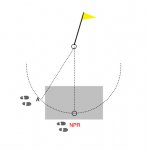Foxholer
Blackballed
Where would we be without Colin's diagrams! :cheers:
I wasn't commenting on any particular post - just an observation.
The NPR must not be nearer the hole than the original spot so the position of the drop cannot be nearer than either. Try the geometry.
Tut Tut!
True. I read more into the comment than was intended. 'Drop' was t.he key word. I withdraw my comment (and apologise). Reversing it wouldn't achieve much after all!Careful!

Indeed. That arc only creates the 'not nearer the pin' boundary.
You would (then) also have to create a circle of least radiest possible around the current ball position - ie nearest - where neither the ball nor stance (and possibly nor swing) intersects with (or is interfered with if relief from swing is allowed) the condition/obstruction - that-s relief. Either ball or stance (or limit of swing) would be on - that establishes 'the point' - the circumference of that circle and, to comply with the 'not nearer the hole requirement, outside the arc created earlier - that's 'not nearer the hole'.
Even I am not inspired to make a diagram of that.
The illustration was simply to show that the ball could roll nearer the hole than the NPR but still not be nearer the hole than the original position of the ball - something of an academic matter which you'd best forget.
If the ball rolls nearer the hole than the NPR alone, you must re-drop even if it is not nearer than the original position.
- still within one club length of the NPR and not nearer the hole - but hey - who said golf should always be fair
You get 2 club lengths, see below
.
.
Quick check on NPR. Ball is on an access track that you can take relief from. Ball is closest to one side. NPR is by definition the edge of the track closest to where the ball was lying given that subsequent stance taken to address ball at NPR is not on the track. The ball can be dropped within one club length of that boundary - it doesn't need to be dropped at the NPR i.e. on the boundary of track and rough.
Pretty much correct.
I would have thought that the boundary of track and rest of course could well be considered track, so onto the normal part of the course sufficient to prevent the swing being affected by the track would be NPR to me.
But certainly, within 1 Club length from there, not nearer the hole.